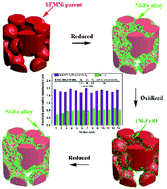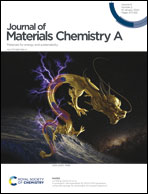Robust redox-reversible perovskite type steam electrolyser electrode decorated with in situ exsolved metallic nanoparticles†
Abstract
Redox stabilities of the hydrogen electrode with in situ exsolved Fe–Ni nanoparticles from Sr2Fe1.4Ni0.1Mo0.5O6−δ (SFMNi) perovskite are studied by analyzing the evolution of the phase composition and morphology during the redox cycles. It is found that certain amount of the exsolved nanoparticles have been oxidized to the transition metal oxide (Ni,Fe)O instead of reincorporating into the parent perovskite lattice upon re-oxidizing at 800 °C in air. However, the (Ni,Fe)O secondary phases show no adverse effect on the subsequent reduction treatment. The redox reversibility mechanism is explained by the regular-solution model. The electrodes are almost fully recovered in the reducing atmosphere, and the symmetrical cells measured under 9.7% H2–3% H2O–87.3% N2 conditions show a stable specific area polarization resistance of around 1.93 Ω cm2 at 800 °C during 13 redox cycles. Single cells using the Ni–Fe nanoparticles structured electrode exhibit a stable electrode polarization resistance of about 0.598 Ω cm2 at 800 °C under open circuit voltage conditions and a steady electrolysis current density of about −653 mA cm−2 at 1.5 V during the steam electrolysis process over 5 redox cycles. These results indicate that the SFMNi material is a very promising electrode candidate for steam electrolysis application with robust redox reversibility.



 Please wait while we load your content...
Please wait while we load your content...